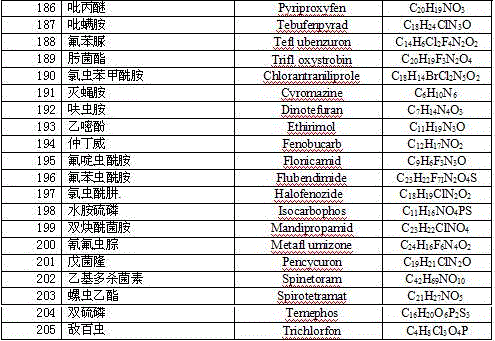A detection method for 205 kinds of pesticide residues in rice
A technology for pesticide residues and detection methods, which is applied in the field of detection of pesticide residues in rice, can solve the problems that cannot meet the actual needs of export rice pesticide residue inspection, and achieve the protection of human health, increase extraction efficiency, and promote import and export trade effect
- Summary
- Abstract
- Description
- Claims
- Application Information
AI Technical Summary
Problems solved by technology
Method used
Image
Examples
Embodiment 1
[0068] The detection method of 205 kinds of pesticide residues in rice of embodiment 1
[0069] 1. Sample extraction: 5g (accurate to 0.01g) rice sample is placed in a 50mL centrifuge tube, add 10mL water, cover, vortex mix for 1 minute, then add 15mL acetonitrile (0.1% acetic acid) to the centrifuge tube, vortex 1 Minutes, then add 6g of anhydrous magnesium sulfate and 1.5g of sodium acetate, shake vigorously for 20s to fully disperse the massive crystals. Centrifuge at a standard speed of 4000 rpm for 5 minutes.
[0070] 2. Extraction purification
[0071] Take 8mL of the upper layer solution from the supernatant after centrifugation, and place it in a 15mL centrifuge tube, which has been added with 400mg of PSA, 1200mg of anhydrous magnesium sulfate, and 400mg of C18, vortexed for 15min, and 4000 rpm standard Spin down for 5 minutes.
[0072] 3. Determination by liquid chromatography-mass spectrometry / mass spectrometer
[0073] The sample and standard working solution w...
PUM
| Property | Measurement | Unit |
|---|---|---|
| ion source temperature | aaaaa | aaaaa |
Abstract
Description
Claims
Application Information
 Login to View More
Login to View More - R&D
- Intellectual Property
- Life Sciences
- Materials
- Tech Scout
- Unparalleled Data Quality
- Higher Quality Content
- 60% Fewer Hallucinations
Browse by: Latest US Patents, China's latest patents, Technical Efficacy Thesaurus, Application Domain, Technology Topic, Popular Technical Reports.
© 2025 PatSnap. All rights reserved.Legal|Privacy policy|Modern Slavery Act Transparency Statement|Sitemap|About US| Contact US: help@patsnap.com



